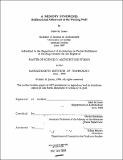A memory syndrome : selfhood and otherness at the Wailing Wall
Author(s)
Jarrar, Sabri M. (Sabri Mohammad)
DownloadFull printable version (8.275Mb)
Alternative title
Selfhood and otherness at the Wailing Wal
Other Contributors
Massachusetts Institute of Technology. Dept. of Architecture.
Advisor
David Friedman.
Terms of use
Metadata
Show full item recordAbstract
Few groups in the world have as long-standing a claim to "peoplehood" as do Jews. Despite the longevity of that claim, however, the problem of instability inherent in objectifying a collective identity has not yet been resolved. The existence and salience of a collective self is assumed at the same time that statements and actions within the group suggest that individuals are not sure of either the group's boundaries or its cultural content. The relationship between "Israeli society" and "the Jewish people" in Israel is loaded with tension, though there is little question in Israel or elsewhere that it is the "fact" of the latter that is responsible for the "fact" of the former. What about the conceptualization of the collective self in terms of a conceptualization of the collective "other"? The Israeli-Arab conflict is not a typical struggle between oppressor and oppressed, but is rather a struggle between stereotypes. When someone tells us who we are and has the power to impose their version of who we are on us -- according us certain rights and duties and denying us others by virtue of their representation of us -- we readily see it as an act of manipulation of the "facts" and the exercise of political power whose relation to reality we may question, even challenge. This analytical work is an attempt at examining some of the controversies generated by the dynamics and politics of manipulation as they structure in Israeli media in general. Architecture will be examined as a special representational medium that deals with signals of high symbolic values. In this endeavor, a recent Israeli project will be employed as an indicator of how architecture can become a viable channel of communication, where opposing groups can talk to each other, using this representational arena as a testing ground for new tendencies.
Description
Thesis (M.S.)--Massachusetts Institute of Technology, Dept. of Architecture, 1990. Includes bibliographical references (leaves 90-91).
Date issued
1990Department
Massachusetts Institute of Technology. Department of ArchitecturePublisher
Massachusetts Institute of Technology
Keywords
Architecture.
